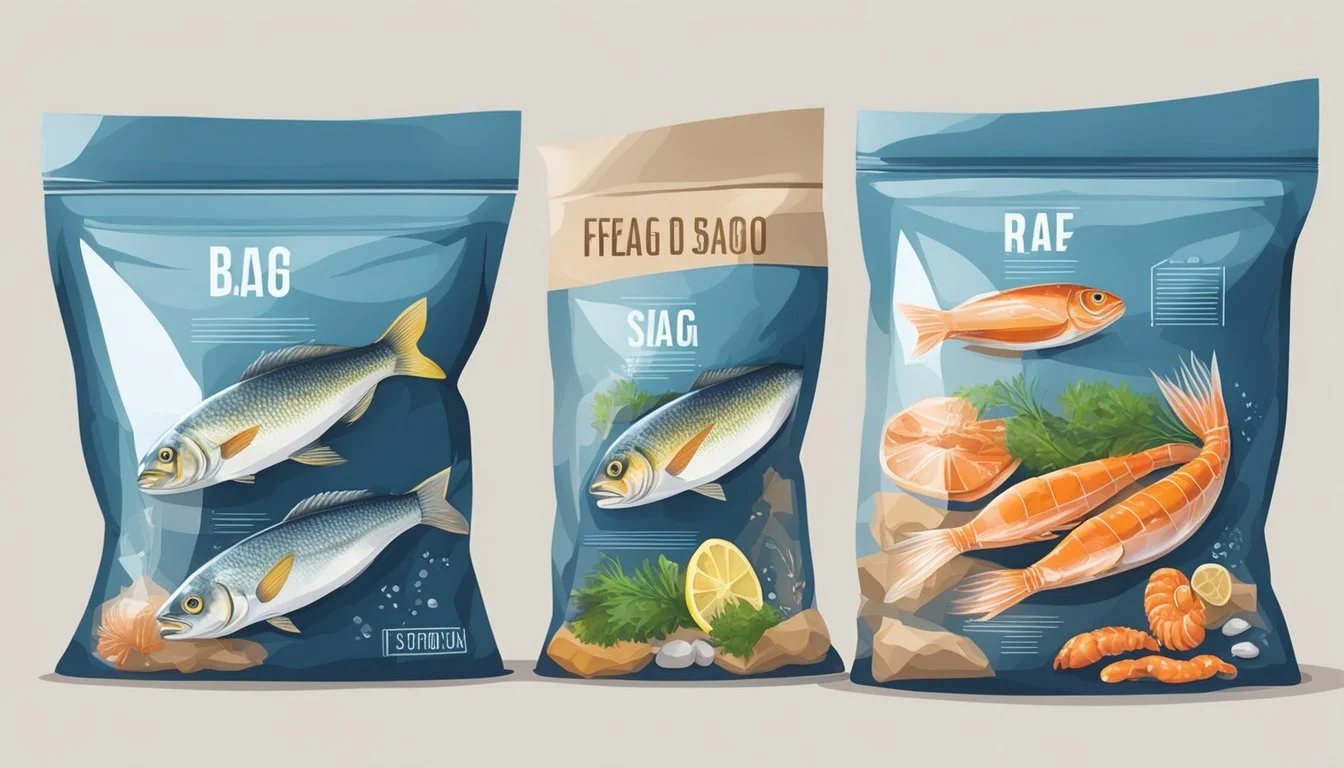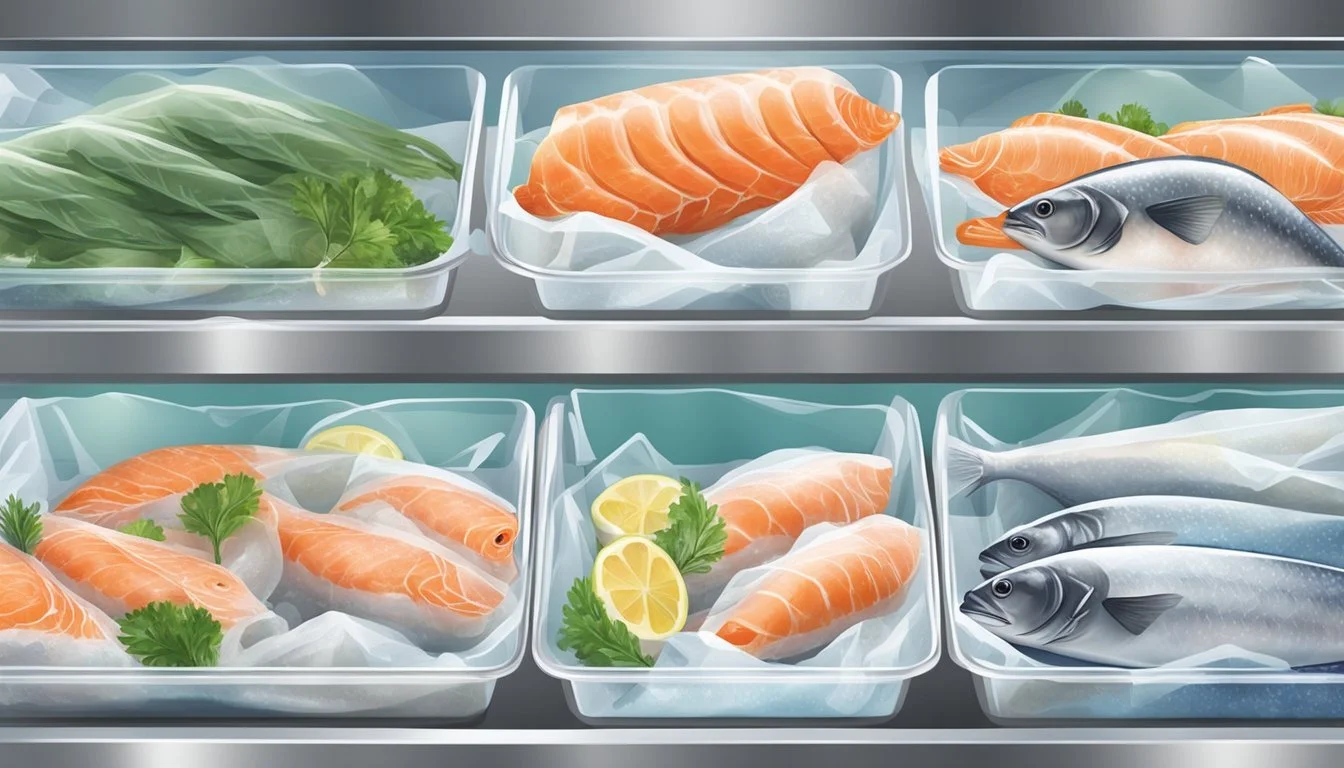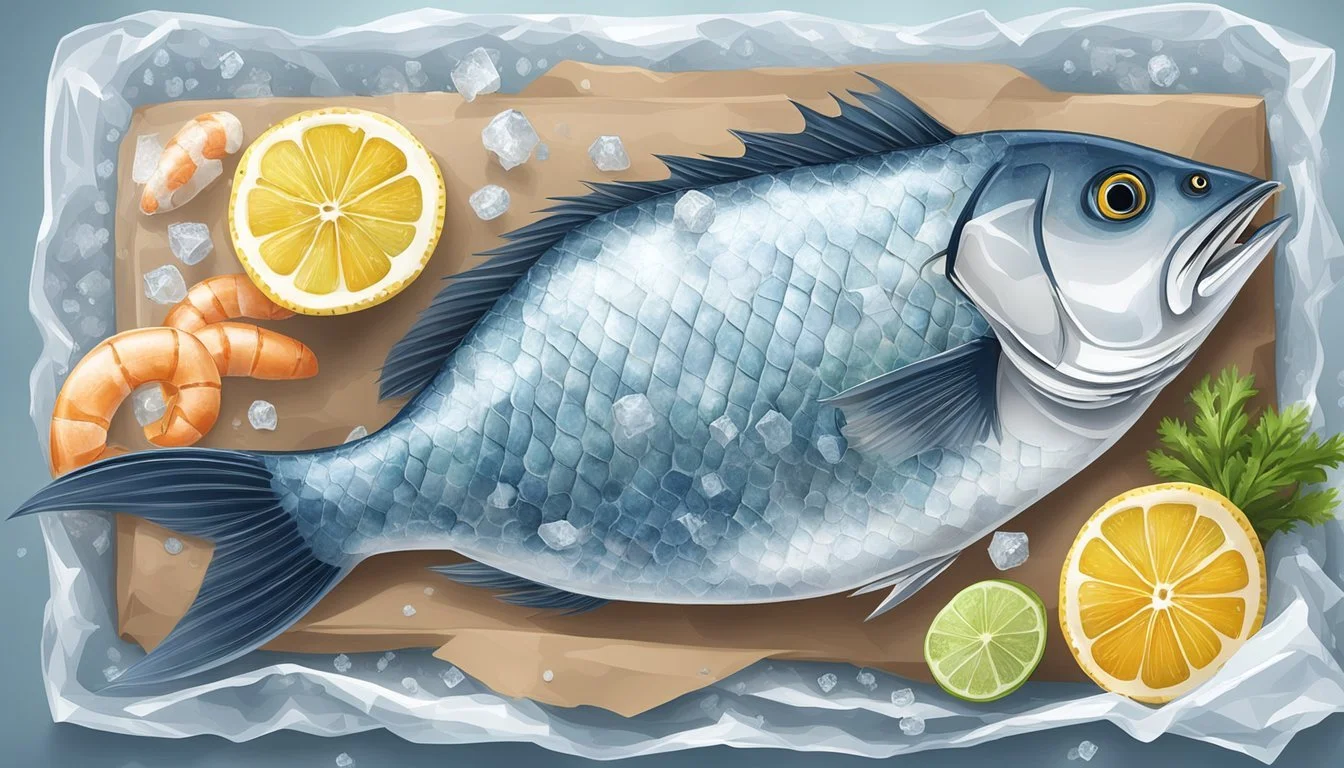How to Freeze Fish and Seafood for Freshness
Best Practices for Home Storage
Freezing fish (What wine goes well with fish?) and seafood (What wine goes well with seafood?) is a time-honored method of preserving the freshness of aquatic delicacies. When executed with precision, this process retains the integrity of flavor, texture, and nutritional value that can be enjoyed well beyond the catch date. Consumers and chefs alike can rely on their freezers to maintain the quality of fresh fish, ensuring a delectable meal even out of season. Whether stocking up on seasonal catches or simply preparing for future culinary ventures, understanding the proper techniques to freeze fish and seafood is integral.
The key to successfully freezing fish lies in minimizing exposure to air, thereby reducing the risk of freezer burn and preserving the fish's original taste and texture. It is advisable to clean and prepare the fish properly before freezing, which typically involves gutting, scaling, and, if preferred, cutting into fillets or steaks. Utilizing materials such as freezer-safe bags, plastic wrap, or vacuum sealing equipment can significantly enhance the shelf life of frozen fish. These materials not only protect against air but also help in maintaining a consistent temperature, which is crucial for the longevity of frozen fish.
Confidence in the freezing process allows for the enjoyment of seafood year-round, providing a practical solution for consumers who value both the taste and nutritional profile of fish. With proper preparation and a solid understanding of the freezing techniques, one can be assured that the essence of the sea is perfectly captured, ready to be thawed and savored at a moment's notice.
Choosing the Right Fish to Freeze
The success of freezing fish and maintaining its quality hinges on selecting appropriate species and ensuring their freshness. It's vital to choose fish that not only freeze well but are also at the peak of freshness when stored.
Identifying Fresh Fish for Freezing
Before freezing, one needs to assess the freshness of the seafood. Fish suitable for freezing should have:
Bright, clear eyes: Cloudy eyes usually signal aging in fish.
Firm flesh: When pressed, the flesh should spring back.
Bright red gills: This indicates a high level of freshness, as gills turn browner with age.
A fresh sea breeze scent: Any strong, fishy, or ammonia-like odors suggest the fish is past its prime.
Best Fish Species for Freezing
Not all fish species freeze with the same efficacy. Some of the best candidates for freezing include:
Fatty fish: Salmon, mackerel, and tuna (What wine goes well with tuna?) are excellent for freezing, their high oil content helps retain moisture and flavor.
Lean whitefish: Species like cod, haddock, and pollock fare well when frozen due to their lower fat content which reduces the risk of rancidity.
Reliable Freezing Candidates Notes on Freezing Salmon High-fat content makes it ideal for freezing. Tuna Best when flash-frozen to preserve texture and taste. Mackerel Should be consumed relatively quickly after freezing. Cod Its lean nature appeals to freezing; its flavor is well-preserved. Haddock Similar to cod, freezes well without significant texture changes. Halibut Large fillets freeze well and maintain structural integrity. Monkfish Known for its firm texture, which remains after thawing.
These species maintain a good texture and flavor after freezing, providing nearly-fresh quality when properly thawed. Avoid freezing oily fish like bluefish, herring, or sardines, as they can become rancid quickly. Additionally, trout is often better when eaten fresh, though it can be frozen if handled correctly.
Preparing Fish for Freezing
Proper preparation of fish for freezing is crucial for preserving its texture and taste. From cleaning and filleting to rinsing and drying, each step helps ensure the seafood maintains its quality during freezing.
Cleaning and Filleting
Before one can freeze fish, it is vital to clean it thoroughly. They should start by removing scales, guts, and any bloodlines. For filleting, the individual should use a sharp knife to separate the meat from the bones, taking care not to leave any pieces behind. One must work with care to maintain the fillet's integrity, which directly impacts the texture upon thawing.
Process:
Remove scales using a fish scaler or the back of a knife.
Slit the belly and remove the innards.
Cut along the backbone to fillet, if desired.
Rinsing and Drying
Once the fish is filleted, a thorough rinse under cold water is necessary to eliminate any residual scales, bones, or internal fluids. The individual must pat the fish dry using paper towels to remove moisture that could lead to ice crystal formation, which can degrade the fish's texture. Upon drying, the fish is ready for freezing, ensuring the preservation of its qualities.
Steps:
Rinse the fish fillets under cold, running water.
Gently pat each fillet dry to minimize moisture.
Freezing Techniques
Proper freezing techniques are essential for maintaining the quality and freshness of fish and seafood. These methods aim to protect the flavor, texture, and moisture content from the detrimental effects of freezer burn and dehydration.
Vacuum Sealing for Longevity
Vacuum sealing significantly extends the shelf life of seafood by removing air from the packaging. When using a vacuum sealer, one should ensure that all parts of the fish are completely sealed, as air exposure can lead to freezer burn. A vacuum-sealed fish can maintain its quality for up to six months in the freezer, depending on the type of fish.
Benefits:
Reduces exposure to air
Minimizes freezer burn
Extends shelf life
Ice Glazing for Moisture Retention
Ice glazing involves coating the fish in a thin layer of ice, which acts as a barrier against moisture loss. To accomplish this, one dips the fish in cold water and places it on a tray lined with parchment paper. After the initial layer of water freezes, the process is repeated to build up a glaze of ⅛ to ¼-inch thick.
Procedure:
Dip fish in cold water
Place on lined tray
Freeze and repeat
Effect:
Preserves moisture
Protects against dehydration
Tray Freezing for Easy Thawing
For easier portioning and thawing, tray freezing is a practical approach. Fish are spread out on a tray, not touching one another, and frozen till firm. Once frozen, they can be transferred to a container or wrapped in plastic wrap for longer storage. This method prevents fish from freezing into a solid block, making it easier to thaw only the amount needed.
Steps:
Arrange fish on tray
Freeze until firm
Store individually
Advantage:
Simplifies individual thawing
Avoids clumping together
Packing and Storing Fish
Proper packing and storage are crucial in preserving the freshness and quality of fish and seafood. Attention to detail in these steps ensures longevity and maintains flavor.
Selecting Storage Containers
Freezer bags and vacuum-sealed bags are the preferred containers for freezing fish due to their airtight qualities, which prevent freezer burn. Butcher paper or freezer paper, followed by an overwrap of plastic film, is also effective, especially for whole fish or large fillets. For those preferring an eco-friendlier method, parchment paper can be used as a buffer before placing the fish in freezer-safe containers. Here's a summary:
Best for Airtightness:
Vacuum-sealed bags
Freezer bags (double-layer for added protection)
Good Alternatives:
Butcher paper or freezer paper (with plastic overwrap)
Parchment paper (as a first wrap layer)
Labeling and Organization
Every package should be clearly labeled with the content's name, quantity, and the freezing date. This practice aids in inventory management and ensures that older supplies are used first, adhering to the first-in, first-out (FIFO) method. Organizing the freezer in sections by fish type and date helps maintain a structured system. It can be helpful to briefly outline a table for logging:
Date Frozen Fish Type Quantity Estimated Use-by Date (Insert) (Insert) (Insert) (Insert)
Packages should be placed on a baking sheet initially to freeze rapidly and then stacked to save space. Use the back of the freezer where the temperature is most consistent.
Thawing Techniques
When thawing fish and seafood, proper techniques are essential to preserve texture and taste. The aim is to maintain quality while bringing the seafood to a state suitable for cooking.
Refrigerator Thawing for Quality Preservation
Thawing fish and seafood in the refrigerator is the recommended method to ensure quality preservation. This slow process allows seafood to gradually come up to an appropriate temperature, which is essential in maintaining its texture and taste. Individuals should place the frozen fish in the refrigerator, ideally on a plate or in a container to catch any drips. The time it takes to thaw varies based on the size and thickness of the fish, but a general rule is to allow a thawing period of 18-24 hours for every five pounds of seafood.
Quick Thawing Methods
Sometimes, there isn't enough time to thaw seafood in the refrigerator. In these cases, one can use quicker methods:
Cold Water Thawing: Seal fish in a leak-proof plastic bag and submerge in cold tap water. Change the water every 30 minutes to ensure it stays cold. This method takes about an hour per pound of seafood.
Microwave Thawing: If time is of the essence, using a microwave's defrost setting is a viable yet less preferred option due to the risk of uneven thawing. It is crucial to cook the fish immediately after microwaving to prevent any parts from entering the danger zone where bacteria can proliferate.
One must ensure that quick thawing methods are followed with immediate cooking to prevent any growth of harmful bacteria and to keep the fish safe for consumption.
Advanced Freezing Tips
Effective freezing methods can significantly extend the freshness and flavor of fish and seafood. Mastery of these techniques ensures that both the taste and nutritional value are preserved for future enjoyment.
Freezing Fatty Fish Varieties
Fatty fish such as salmon, mackerel, and trout are known for their rich flavor, which comes from their high oil content. To freeze these types properly, it's crucial to first pat the fish dry with paper towels. One should then wrap the fish tightly in plastic wrap, followed by aluminum foil or a vacuum-sealed bag to protect it from freezer burn and flavor loss. A layer of glaze, formed by dipping the fish in ice-cold water and freezing until a ⅛- to ¼-inch thick layer of ice forms, adds further protection.
Steps for Glazing:
Dip the fish in ice-cold water.
Place on a tray lined with parchment paper.
Freeze until a thin layer of ice forms.
Repeat the process to build up a glaze.
Managing Freezer Capacity and Temperature
To maintain the quality of frozen fish and seafood, managing the freezer's capacity and temperature is essential. Freezers should not be overloaded, as this can lead to uneven freezing and a drop in temperature. Each type of fish may have specific freezing time requirements, but a general rule is to freeze quickly and store at a constant temperature of 0°F (-18°C) or below.
Freezer Temperature Guidelines:
Maintain a constant 0°F (-18°C)
Ensure the freezer is not too full, allowing air to circulate
Freeze fish in smaller portions for quicker freezing time
For long-term storage, it is advisable to invest in a deep freezer, which can sustain colder temperatures vital for preserving the integrity of the fish. Freezing whole fish is feasible, especially for smaller varieties, but they must be cleaned, gutted, and prepped properly before freezing.
Using these advanced tips, one can freeze various types of fish, extending the longevity and freshness of the catch or purchase.
Special Cases and Exceptions
When freezing fish and seafood, certain special cases demand additional care to maintain freshness and flavor. These exceptions primarily involve different types of seafood and already cooked or smoked fish.
Seafood and Shellfish Considerations
Lobsters and Shucked Clams: Lobsters (What wine goes well with lobster?) should be alive before freezing. For optimal texture, one can freeze lobsters by first placing them in a brine solution before freezing. Clams should be shucked, cleaned, and the meat can then be frozen in a brine solution to preserve taste and moisture.
Scallops: Scallops (What wine goes well with scallops?) freeze well, but they must be patted dry and placed in a single layer on a tray to freeze individually before transferring them into airtight containers. This prevents them from freezing into a solid block, allowing for individual portions to be used as needed.
Tips for Freezing Smoked and Pre-Cooked Fish
Smoked Fish: Smoked fish is already preserved through the smoking process, yet freezing can extend its shelf life. One should wrap smoked fish tightly in vacuum-sealed bags to prevent freezer burn that would degrade its complex flavors.
Pre-Cooked Fish: For fish that has been cooked, cooling it rapidly before freezing is crucial. It must be stored in airtight, moisture-proof containers or freezer bags. Label each container with the freezing date to ensure it's used while at its best quality.
By adhering to these tailored steps, one can ensure that specialty seafood items and pre-processed fish retain their freshness and desired taste upon thawing.
Maintaining Freshness after Freezing
When freezing fish and seafood, the objective is to preserve its taste and flavor for as long as possible. A critical aspect is the storage temperature – it should remain at 0 degrees Fahrenheit or lower.
Preparation for Freezing:
Clean fish thoroughly before freezing. Remove scales, guts, and gills, which can harbor bacteria, affecting flavor.
Pat fish dry to prevent ice crystals that can degrade meat quality.
Cut into meal-sized portions for ease of use later.
Packaging:
Use moisture-proof plastic wrap, freezer bags, or vacuum-sealed packaging.
Double-wrap or use multiple bags to prevent freezer burn and odor transfer.
Label packages with the freezing date and type of fish.
Thawing Tips:
Never thaw fish at room temperature. Use the refrigerator for a slow, safe thaw.
For faster thawing, submerge fish in cold water, ensuring it is in a leak-proof package.
Change water every 30 minutes to maintain cold temperature and facilitate even thawing.
Thaw fish for an estimated 30 minutes per pound, depending on size and thickness.
Cooking Post-Thaw:
Cook thawed fish immediately to maintain optimal flavor and texture.
Discard fish if it has been thawed for more than two hours at room temperature.
By meticulously following these steps, consumers can enjoy the freshness of their fish and seafood long after it has been frozen. Remember, proper handling before and after freezing is essential for maintaining the best quality of frozen meats.
Transporting Frozen Fish
When transporting frozen fish, maintaining a consistently low temperature is crucial for preserving freshness and preventing spoilage. Proper insulation and handling are key factors in this process.
Using Coolers and Ice Packs
The person tasked with transporting frozen fish should ensure they have a high-quality cooler that can maintain the required temperature for the duration of the journey. Here are specific steps to prepare fish for transport:
Pre-chill the cooler: Place ice packs or gel packs in the cooler for several hours before adding the fish.
Wrap fish: Individually wrap each fish or fillet in plastic wrap or vacuum-sealed bags to prevent air exposure and freezer burn.
Layer with ice packs: Place frozen fish in the cooler and intersperse with additional ice packs to ensure even cooling throughout.
Handling Fish during Travel
While traveling, handling frozen fish properly is necessary to prevent temperature fluctuations. Consider these tips:
Immediate Transfer: Frozen fish should be moved from freeze to cooler swiftly to minimize thawing.
Minimize Openings: Open the cooler as infrequently as possible to keep the cold air inside.
Assess Temperature: Regularly check the temperature within the cooler to ensure it remains at or below 0°F.
With these measures, individuals and businesses can effectively preserve the quality of frozen fish during transportation.




